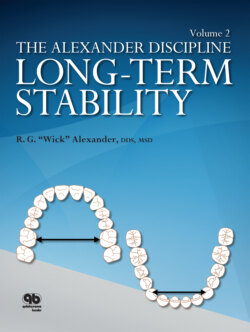Читать книгу The 20 Principles of the Alexander Discipline, Volume 2 - R.G. "Wick" Alexander - Страница 15
На сайте Литреса книга снята с продажи.
Case 1-2
ОглавлениеOverview
This patient was first examined when my office had been open for only 12 days, at which time I had no education in treating mixed dentition malocclusions or any guidance in the use of cervical facebows.
Examination and diagnosis
A 7-year-old girl presented a mixed dentition with a Class II, Division 1 malocclusion. Her overbite was 4 mm, she had an overjet of 7 mm, and there was a mandibular arch-length discrepancy of 4 mm in the mixed dentition. The treatment objectives included the correction of the overjet and Class II molar relationship without the removal of permanent teeth.
Treatment plan
The treatment plan called for banding the maxillary permanent teeth (2 × 4) with a tied-back archwire and having the patient wear a cervical facebow 12 to 14 hours a day. If I were treating this patient today, I would divide this treatment into two phases, but at the time, I continued treatment until the permanent teeth could be banded and properly positioned.
Evaluation
Total treatment time was 39 months. The patient was retained with a maxillary wrap-around retainer and mandibular 3 × 3 for 3 years.
Discussion
Postretention records were taken 40 years after starting her treatment (36 years posttreatment and 33 years postretention). Final results demonstrate a very stable dentition in keeping with the goals we hope to attain in all of our cases.
This patient will always be remembered as my first mixed dentition and cervical facebow case. Without my having experience to predict a successful result, this patient cooperated and taught me valuable lessons in Class II treatment and eventually was used as an American Board case in 1972.
Table 1-3 Archwire sequence
| Archwire | Duration (months) | |
|---|---|---|
| Maxillary | ||
| 0.014 SS | 12 | |
| 0.016 SS | 7 | |
| 17 × 25 SS | 20 | |
| Active treatment time: | 39 months | |
| Mandibular | ||
| None | 30 | |
| 0.014 SS | 2 | |
| 0.018 SS | 6 | |
| Active treatment time: | 8 months |
Table 1-4 Individualized forces
| Force | Duration (months) |
|---|---|
| Cervical facebow | 20 |
Case 1-2
Figs 1-3a to 1-3c Pretreatment facial views, age 7 years. (a) Soft tissue profile shows retrognathic mandible. (b) Frontal view shows lips strained. (c) Smile shows flared anterior teeth.
Figs 1-3d to 1-3f Pretreatment intraoral models show a Class II molar relationship, an overbite of 4 mm, and an overjet of 7 mm.
Figs 1-3g and 1-3h Pretreatment occlusal models. Initial maxillary intermolar width: 28.6 mm; initial mandibular intercanine width: 25.5 mm. (g) Maxillary midline diastema is present, along with flared anterior teeth. (h) Mandibular discrepancy of 4 mm.
Fig 1-3i Pretreatment cephalometric tracing shows a Class II, Division 1 malocclusion and a retrognathic mandible.
Figs 1-3j to 1-3l Final facial views, age 10 years. (j) Soft tissue profile is balanced. (k) Frontal view shows lips together with no strain. (l) Smile shows nice balance.
Figs 1-3m to 1-3o Final occlusion shows a Class I molar relationship, a midline that is coincident, and a normal overbite and overjet.
Figs 1-3p and 1-3q Final occlusal models show excellent arch forms. Final maxillary intermolar width: 32.0 mm; final mandibular intercanine width: 25.5 mm.
Fig 1-3r Final cephalometric tracing (left) and composite of pretreatment (black) and final (red) cephalometric tracings (right).
Figs 1-3s to 1-3u Facial views 40 years posttreatment.
Figs 1-3v to 1-3x Intraoral views 40 years posttreatment.
Figs 1-3y and 1-3z Occlusal views 40 years posttreatment. Maxillary intermolar width: 31.8 mm; mandibular intercanine width: 22.5 mm.
Fig 1-3bb Panoramic radiograph 40 years posttreatment.
Fig 1-3aa Pretreatment (black), final (red), and 40-year posttreatment (green) cephalometric tracing comparison.
